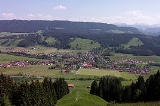
Weitnau
Encyclopedia
Weitnau is a municipality in the rural district Oberallgäu
in Bavaria
/Germany
. Together with the neighboring municipality of Missen-Wilhams
, Weitnau shares an administrative unit.
region in the foothills of the Bavarian Alps
. The municipality consists of the town Weitnau and the villages of Seltmans, Sibratshofen, Kleinweiler, Hellengerst, Rechtis and Wengen; in addition to that there are several small hamlets, most notably Waltrams
, Gerholz, Engelhirsch, Eisenbolz, Ettensberg, Klausenmühle and Weilerle. The town Weitnau lies in a valley bordered to the north by the Sonneck mountain (elev. 1109 m.) and to the south by the Hauchenberg mountain (elev. 1243 m.). The stream Weitnauer Bach has its source in the east of the municipality's area and flows into the 49 miles long river Argen
in Seltmans. The Argen river itself flows into Lake Constance
and thus is a tributary to the river Rhine, one of Germany's major rivers.
name. The prefix
"witun" might be traced back to Old High German "wittan" meaning "to widen" or "make wider"; the suffix
"avia" might be traced back to the Old High German "awia" meaning "land by the water". Thus Witunavia can roughly be translated to "broad pastures by a stream", a term which certainly does justice to a small stream settlement in a wide valley. Over the centuries the term was shortened and the suffix changed first to "Witenowe" - possibly Middle High German
as the new suffix "owe" suggests - in the 12th century. Then to Weitnaw by the 16th century and Weüttnau by the 18th century. Around 1834 Weitnau was finally referred to as "Weidnau".
from the east and Veneti
from the west started settling in the Allgäu. Argen is an Illyrian name and probably means "forest stream". In 90 AD, the Roman road from Cambodunum (Kempten
) to Brigantium (Bregenz
) led through the Wengen valley, where a Roman
milestone was found in 1500.
It is believed that Weitnau was mentioned for the first time in 726 as "Witunavia". It is certain that in 1250 Weitnau was mentioned as "Witenove".
Before it was ceded to Bavaria under the peace treaties of Brünn and Pressburg in 1805, Weitnau belonged to the Austrian House of Bregenz-Hohenegg. As early as in the 13th century, Weitnau was an administrative center, the legal domicile of the House of Bregenz-Hohenegg and enjoyed the right to hold a market. In 1760, the last execution took place when a certain Lukas Bentele a "petty thief and idler" was decapitated by executioner Jakob Räß.
World War II took a heavy toll of lives, several dozen young men from the municipality fell on the frontlines in the West and particularly the East. Towards the end of the war, in April 1945, Weitnau was occupied first by French
then by Moroccan
troops, the French/Moroccans left in July of the same year, and American
troops took over occupation duties in Weitnau.
Rechtis-Hellengerst, then only a rural community, voluntarily joined the municipality of Weitnau in 1963, in 1973 the municipality of Wengen was incorporated into the municipality of Weitnau when a regional reorganization of municipalities in Bavaria took place. Weitnau has been recognized as a climatic health resort since December 2005.
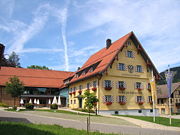
retired from his office after four consecutive terms.
Freytag has been succeeded by Alexander Streicher, the first ever independent major of Weitnau and originally a resident of Neufahrn
near Munich
. After an unprecedented election campaign which turned into a neck-and-neck race with conservative candidate Siegfried Zengerle, Streicher snatched an unexpected, yet in the end relatively comfortable, victory on election day. During the election campaign, which saw numerous public appearances of both candidates and even a panel discussion, both candidates had gained a reputation for being persons of integrity and competence.
Streicher took up office on 1 May.
A new industrial estate is currently being developed to the west of Weitnau offering opportunities for a number of new businesses. A superstore and a drinks cash-and-carry are to be opened there by the end of 2008.
Furthermore, there are 145 farms cultivating some 34 square kilometres of agricultural land and 28 square kilometres of woodland in the municipality.
In school year 2006/2007, some 420 pupils in 18 classes are taught by 29 teachers and tutors.
Two nursery schools, also in Weitnau and Kleinweiler, with 14 attendants serve the needs of young families.
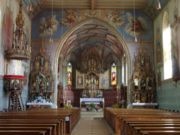
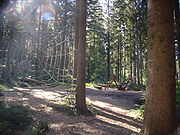
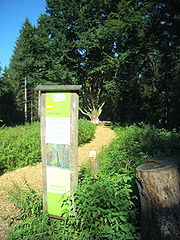 • Hauchenberg and "Alpkönigblick"; on top of the Hauchenberg mountain a lookout tower was constructed in 2007 with the help of helicopter airlifts. At a height of 1240 m., the "Alpkönigblick", which was officially opened on 21 October 2007 by the Bavarian State Minister of Agriculture and Forestry Josef Miller, offers scenic views of the Weitnau valley and surrounding landscape to the north, and the German, Austrian and Swiss Alps
• Hauchenberg and "Alpkönigblick"; on top of the Hauchenberg mountain a lookout tower was constructed in 2007 with the help of helicopter airlifts. At a height of 1240 m., the "Alpkönigblick", which was officially opened on 21 October 2007 by the Bavarian State Minister of Agriculture and Forestry Josef Miller, offers scenic views of the Weitnau valley and surrounding landscape to the north, and the German, Austrian and Swiss Alps
to the south. A short stroll away Kling's Alpe, a licenced mountain hut offering food and service to hikers at weekends, opened in September 2007.
• St. Pelagius Church; the neo-Gothic church of the town of Weitnau. Reconstructed in part 1862-72. In all probability only the nave
was reconstructed, the choir
, which was built in 1739-1740, was very likely retained. Parts of the spire date back to the 14th century. The church is considered a neo-Gothic sacred building, it features numerous elaborate stencil drawings and colourful embelishments. The statues of the high altar
originate from the Multscher School and date back to around 1490. Station of the Jakobus Pilgrimage Trail
• Alttrauchburg Castle Ruins; extensively reconstructed castle
ruins with inn and beer garden overlooking the village Kleinweiler. The Alttrauchburg can be reached via signposted hiking trails in approximately an hour from Weitnau.
• Adler Guesthouse; guesthouse in the town of Weitnau which used to house the official chambers of the House of Bregenz-Hohenegg. Probably built in 1753. Today a restaurant and guesthouse which also houses the public library, the tourism office and a small museum.
• 18-Hole Golf Course in Hellengerst which offers panoramic views of the Alps.
• Argental Skilifte; Two ski lifts offer well-prepared pistes for beginners and seasoned skiers and snowboarders. The 500-metre-long family lift, a modern T-bar lift with a difference in altitude of 120 metres, was completely rebuilt in the early 2000s. In addition, there is a 100-metre beginners lift with a difference in altitude of 20 metres. Right next to the beginners lift, a short run is usually prepared for sledges and toboggans. The "Cafe Widdumstüble" provides food as well as hot and cold drinks. Weitnau's cross-country skiing
network has its starting point here and is regularly tracked from here.
, a municipality in the north-west of France near the Atlantic Coast
, since 1986.
• Website local sports club with pictures - German
• Website local school with pictures - German
• Website local fire brigade with pictures - German
• Golf course Hellengerst - German and English
• Website ski lift - German with pictures
• Weitnau Pension - German with pictures
Oberallgäu
Oberallgäu is a district in Bavaria, Germany. It is bounded by the districts of Unterallgäu and Ostallgäu, the Austrian states Tyrol and Vorarlberg, the district of Lindau, and the state of Baden-Württemberg...
in Bavaria
Bavaria
Bavaria, formally the Free State of Bavaria is a state of Germany, located in the southeast of Germany. With an area of , it is the largest state by area, forming almost 20% of the total land area of Germany...
/Germany
Germany
Germany , officially the Federal Republic of Germany , is a federal parliamentary republic in Europe. The country consists of 16 states while the capital and largest city is Berlin. Germany covers an area of 357,021 km2 and has a largely temperate seasonal climate...
. Together with the neighboring municipality of Missen-Wilhams
Missen-Wilhams
Missen-Wilhams is a municipality in the district of Oberallgäu in Bavaria....
, Weitnau shares an administrative unit.
Geography
Weitnau is situated in the AllgäuAllgäu
The Allgäu is a southern German region in Swabia. It covers the south of Bavarian Swabia and southeastern Baden-Württemberg. The region stretches from the prealpine lands up to the Alps...
region in the foothills of the Bavarian Alps
Alps
The Alps is one of the great mountain range systems of Europe, stretching from Austria and Slovenia in the east through Italy, Switzerland, Liechtenstein and Germany to France in the west....
. The municipality consists of the town Weitnau and the villages of Seltmans, Sibratshofen, Kleinweiler, Hellengerst, Rechtis and Wengen; in addition to that there are several small hamlets, most notably Waltrams
Waltrams
Waltrams is a village located outside the town of Weitnau, in the Oberallgäu district of Bavaria, Germany....
, Gerholz, Engelhirsch, Eisenbolz, Ettensberg, Klausenmühle and Weilerle. The town Weitnau lies in a valley bordered to the north by the Sonneck mountain (elev. 1109 m.) and to the south by the Hauchenberg mountain (elev. 1243 m.). The stream Weitnauer Bach has its source in the east of the municipality's area and flows into the 49 miles long river Argen
Argen
The Argen is a river in Baden-Württemberg, Germany. It flows into Lake Constance between Kressbronn am Bodensee and Langenargen as the third largest tributary to the lake. It is 23.4 km long; if one includes the Upper Argen, the combined length is 51.4 km.- Course :The headwaters of the...
in Seltmans. The Argen river itself flows into Lake Constance
Lake Constance
Lake Constance is a lake on the Rhine at the northern foot of the Alps, and consists of three bodies of water: the Obersee , the Untersee , and a connecting stretch of the Rhine, called the Seerhein.The lake is situated in Germany, Switzerland and Austria near the Alps...
and thus is a tributary to the river Rhine, one of Germany's major rivers.
Etymology
The name Weitnau is derived from the earliest names given to settlements in the valley. Such names can be traced back to the 8th century A.D. when a settlement in the Weitnau valley was referred to as "Witunavia", possibly an Old High GermanOld High German
The term Old High German refers to the earliest stage of the German language and it conventionally covers the period from around 500 to 1050. Coherent written texts do not appear until the second half of the 8th century, and some treat the period before 750 as 'prehistoric' and date the start of...
name. The prefix
Prefix
A prefix is an affix which is placed before the root of a word. Particularly in the study of languages,a prefix is also called a preformative, because it alters the form of the words to which it is affixed.Examples of prefixes:...
"witun" might be traced back to Old High German "wittan" meaning "to widen" or "make wider"; the suffix
Suffix
In linguistics, a suffix is an affix which is placed after the stem of a word. Common examples are case endings, which indicate the grammatical case of nouns or adjectives, and verb endings, which form the conjugation of verbs...
"avia" might be traced back to the Old High German "awia" meaning "land by the water". Thus Witunavia can roughly be translated to "broad pastures by a stream", a term which certainly does justice to a small stream settlement in a wide valley. Over the centuries the term was shortened and the suffix changed first to "Witenowe" - possibly Middle High German
Middle High German
Middle High German , abbreviated MHG , is the term used for the period in the history of the German language between 1050 and 1350. It is preceded by Old High German and followed by Early New High German...
as the new suffix "owe" suggests - in the 12th century. Then to Weitnaw by the 16th century and Weüttnau by the 18th century. Around 1834 Weitnau was finally referred to as "Weidnau".
History
1200 - 800 before Christ, IllyriansIllyrians
The Illyrians were a group of tribes who inhabited part of the western Balkans in antiquity and the south-eastern coasts of the Italian peninsula...
from the east and Veneti
Adriatic Veneti
The Veneti were an ancient people who inhabited north-eastern Italy, in an area corresponding to the modern-day region of the Veneto....
from the west started settling in the Allgäu. Argen is an Illyrian name and probably means "forest stream". In 90 AD, the Roman road from Cambodunum (Kempten
Kempten
Kempten can refer to:* Kempten im Allgäu, a town in Bavaria, Germany* Kempten ZH, a district of the town of Wetzikon in the canton of Zurich, Switzerland* Kempton Park, Gauteng, a city in South Africa which was named after Kempten in Bavaria...
) to Brigantium (Bregenz
Bregenz
-Culture:The annual summer music festival Bregenzer Festspiele is a world-famous festival which takes place on and around a stage on Lake Constance, where a different opera is performed every second year.-Sport:* A1 Bregenz HB is a handball team....
) led through the Wengen valley, where a Roman
Ancient Rome
Ancient Rome was a thriving civilization that grew on the Italian Peninsula as early as the 8th century BC. Located along the Mediterranean Sea and centered on the city of Rome, it expanded to one of the largest empires in the ancient world....
milestone was found in 1500.
It is believed that Weitnau was mentioned for the first time in 726 as "Witunavia". It is certain that in 1250 Weitnau was mentioned as "Witenove".
Before it was ceded to Bavaria under the peace treaties of Brünn and Pressburg in 1805, Weitnau belonged to the Austrian House of Bregenz-Hohenegg. As early as in the 13th century, Weitnau was an administrative center, the legal domicile of the House of Bregenz-Hohenegg and enjoyed the right to hold a market. In 1760, the last execution took place when a certain Lukas Bentele a "petty thief and idler" was decapitated by executioner Jakob Räß.
World War II took a heavy toll of lives, several dozen young men from the municipality fell on the frontlines in the West and particularly the East. Towards the end of the war, in April 1945, Weitnau was occupied first by French
France
The French Republic , The French Republic , The French Republic , (commonly known as France , is a unitary semi-presidential republic in Western Europe with several overseas territories and islands located on other continents and in the Indian, Pacific, and Atlantic oceans. Metropolitan France...
then by Moroccan
Morocco
Morocco , officially the Kingdom of Morocco , is a country located in North Africa. It has a population of more than 32 million and an area of 710,850 km², and also primarily administers the disputed region of the Western Sahara...
troops, the French/Moroccans left in July of the same year, and American
United States
The United States of America is a federal constitutional republic comprising fifty states and a federal district...
troops took over occupation duties in Weitnau.
Rechtis-Hellengerst, then only a rural community, voluntarily joined the municipality of Weitnau in 1963, in 1973 the municipality of Wengen was incorporated into the municipality of Weitnau when a regional reorganization of municipalities in Bavaria took place. Weitnau has been recognized as a climatic health resort since December 2005.
Population Development
Weitnau's population has increased considerably since it reached a low in 1987 when only 3.873 citizens were counted. In 2005, 5.209 citizens were registered. Sustainable development of attractive new building grounds should guarantee a moderate increase of the population.
Politics
In May 2008 major Peter Freytag of the conservative CSUChristian Social Union of Bavaria
The Christian Social Union in Bavaria is a Christian democratic and conservative political party in Germany. It operates only in the state of Bavaria, while its sister party, the Christian Democratic Union , operates in the other 15 states of Germany...
retired from his office after four consecutive terms.
Freytag has been succeeded by Alexander Streicher, the first ever independent major of Weitnau and originally a resident of Neufahrn
Neufahrn
Neufahrn may refer to two municipalities in Bavaria, Germany:*Neufahrn bei Freising, in Upper Bavaria*Neufahrn , in Lower Bavaria...
near Munich
Munich
Munich The city's motto is "" . Before 2006, it was "Weltstadt mit Herz" . Its native name, , is derived from the Old High German Munichen, meaning "by the monks' place". The city's name derives from the monks of the Benedictine order who founded the city; hence the monk depicted on the city's coat...
. After an unprecedented election campaign which turned into a neck-and-neck race with conservative candidate Siegfried Zengerle, Streicher snatched an unexpected, yet in the end relatively comfortable, victory on election day. During the election campaign, which saw numerous public appearances of both candidates and even a panel discussion, both candidates had gained a reputation for being persons of integrity and competence.
Streicher took up office on 1 May.
Economy
A number of small and medium-sized companies are located within the community area. Metal- and plastics-processing companies are to be found as well as a larger number of trades. According to the community's website, 373 companies are registered currently; there are 49 workshops, 18 companies in the catering trade, a number of retailers and 17 industrial companies.A new industrial estate is currently being developed to the west of Weitnau offering opportunities for a number of new businesses. A superstore and a drinks cash-and-carry are to be opened there by the end of 2008.
Furthermore, there are 145 farms cultivating some 34 square kilometres of agricultural land and 28 square kilometres of woodland in the municipality.
Education
The Volksschule (elementary and secondary school) Weitnau serves a large catchment area. Apart from pupils of the municipality of Weitnau, recently also pupils from the neighboring community of Mizzen have been taught in Weitnau. The Volksschule consists of the main building in Weitnau, which was extended and refurbished in the mid-1990s, and a small branch in the village Kleinweiler.In school year 2006/2007, some 420 pupils in 18 classes are taught by 29 teachers and tutors.
Two nursery schools, also in Weitnau and Kleinweiler, with 14 attendants serve the needs of young families.

Sights and Places of Interest
• Carl-Hirnbein-Erlebnisweg; an adventure hiking trail between Weitnau and Missen featuring attractions, playgrounds and sheltered places for rest. Numerous displays provide detailed information about the flora and fauna in the surrounding forrest and invite hikers to participate in games and to solve educative riddles and anagrams.

Swiss Alps
The Swiss Alps are the portion of the Alps mountain range that lies within Switzerland. Because of their central position within the entire Alpine range, they are also known as the Central Alps....
to the south. A short stroll away Kling's Alpe, a licenced mountain hut offering food and service to hikers at weekends, opened in September 2007.
• St. Pelagius Church; the neo-Gothic church of the town of Weitnau. Reconstructed in part 1862-72. In all probability only the nave
Nave
In Romanesque and Gothic Christian abbey, cathedral basilica and church architecture, the nave is the central approach to the high altar, the main body of the church. "Nave" was probably suggested by the keel shape of its vaulting...
was reconstructed, the choir
Choir
A choir, chorale or chorus is a musical ensemble of singers. Choral music, in turn, is the music written specifically for such an ensemble to perform.A body of singers who perform together as a group is called a choir or chorus...
, which was built in 1739-1740, was very likely retained. Parts of the spire date back to the 14th century. The church is considered a neo-Gothic sacred building, it features numerous elaborate stencil drawings and colourful embelishments. The statues of the high altar
Altar
An altar is any structure upon which offerings such as sacrifices are made for religious purposes. Altars are usually found at shrines, and they can be located in temples, churches and other places of worship...
originate from the Multscher School and date back to around 1490. Station of the Jakobus Pilgrimage Trail
• Alttrauchburg Castle Ruins; extensively reconstructed castle
Castle
A castle is a type of fortified structure built in Europe and the Middle East during the Middle Ages by European nobility. Scholars debate the scope of the word castle, but usually consider it to be the private fortified residence of a lord or noble...
ruins with inn and beer garden overlooking the village Kleinweiler. The Alttrauchburg can be reached via signposted hiking trails in approximately an hour from Weitnau.
• Adler Guesthouse; guesthouse in the town of Weitnau which used to house the official chambers of the House of Bregenz-Hohenegg. Probably built in 1753. Today a restaurant and guesthouse which also houses the public library, the tourism office and a small museum.
• 18-Hole Golf Course in Hellengerst which offers panoramic views of the Alps.
• Argental Skilifte; Two ski lifts offer well-prepared pistes for beginners and seasoned skiers and snowboarders. The 500-metre-long family lift, a modern T-bar lift with a difference in altitude of 120 metres, was completely rebuilt in the early 2000s. In addition, there is a 100-metre beginners lift with a difference in altitude of 20 metres. Right next to the beginners lift, a short run is usually prepared for sledges and toboggans. The "Cafe Widdumstüble" provides food as well as hot and cold drinks. Weitnau's cross-country skiing
Cross-country skiing
Cross-country skiing is a winter sport in which participants propel themselves across snow-covered terrain using skis and poles...
network has its starting point here and is regularly tracked from here.
Twin Town
Weitnau has been twinned with MagnéMagné
Magné may refer to the following places in France:* Magné, Deux-Sèvres, a commune in the Deux-Sèvres department* Magné, Vienne, a commune in the Vienne department...
, a municipality in the north-west of France near the Atlantic Coast
Atlantic Ocean
The Atlantic Ocean is the second-largest of the world's oceanic divisions. With a total area of about , it covers approximately 20% of the Earth's surface and about 26% of its water surface area...
, since 1986.
External links
• Website Weitnau with pictures - German• Website local sports club with pictures - German
• Website local school with pictures - German
• Website local fire brigade with pictures - German
• Golf course Hellengerst - German and English
• Website ski lift - German with pictures
• Weitnau Pension - German with pictures

